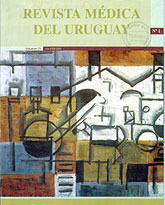Traumatismos y perforaciones de esófago
Diez años de experiencia
Resumen
Introducción: las lesiones esofágicas tienen una alta mortalidad y un tratamiento aún controvertido. Por su baja frecuencia de presentación estas lesiones tienen un problema diagnóstico y terapéutico importante. El objetivo es mostrar los resultados de nuestra serie y distintas opciones de tratamiento.
Material y método: se analizaron en forma retrospectiva 20 pacientes con perforación esofágica excluyendo las fístulas esófago-aéreas, las perforaciones neoplásicas espontáneas y las fallas de sutura. Se estudia la mortalidad en relación con la forma clínica de presentación, tiempo de evolución y al procedimiento terapéutico realizado.
Resultados: las causas más frecuentes de la serie fueron la instrumental (35%) y la ruptura espontánea (30%). El dolor torácico, el derrame pleural y la fiebre fueron los síntomas más constantes. Se señalan distintas opciones terapéuticas, siendo la sutura primaria con o sin refuerzo el procedimiento más utilizado. La mortalidad global fue de 40%.
Conclusiones: el tratamiento debe adecuarse a cada paciente y situación, reservándose el tratamiento médico para casos seleccionados. La forma clínica de presentación tiene un importante valor pronóstico.
Citas
2) Goldstein LA, Thompson WR. Esophageal perforations: a 15 year experience. Am J Surg 1982; 143(4): 495-503.
3) Ruso L, González F, Bogliaccini G, Morelli R. Rotura espontánea de esófago: cuatro observaciones. Cir Urug 1991; 61(1/2): 60-3.
4) Lawrence DR, Ohri SK, Moxon RE, Townsend ER, Fountain SW. Primary esophageal repair for Boerhaave’s syndrome. Ann Thorac Surg 1999; 67(3): 818-20.
5) Wang N, Razzouk AJ, Safavi A, Gan K, Van-Arsdell GS, Burton PM, et al. Delayed primary repair of intrathoracic esophageal perforation: is it safe? J Thorac Cardiovasc Surg 1996; 111(1): 114-22.
6) Abbott OA, Mansour KA, Logan WD Jr, Hatcher CR Jr, Symbas PN. Atraumatic so- called "spontaneous" rupture of the esophagus. J Thorac Cardiovasc Surg 1970; 59(1): 67-83.
7) Tilanus HW, Bossuyt P, Schattenkerk ME, Obertop H. Treatment of oesophageal perforation: a multivariate analysis. Br J Surg 1991; 78(5): 582-5.
8) Giudicelli R. Les perforations de l’œsophage. Résultats d’une enquesta nationale. Ann Chir 1992; 46(2): 183-7.
9) Jones WG 2nd, Ginsberg RJ. Esophageal perforation: continuing challenge. Ann Thorac Surg 1992; 53(3): 534-43.
10) Schauer PR, Meyers WC, Eubanks S, Norem RF, Franklin M, Pappas TN. Mechanisms of gastric and esophageal perforations during laparoscopic Nissen fundoplication. Ann Surg 1996; 223(1): 43-52.
11) Richelme H, Bourgeon A, Ferrari C, Michels-Galy M. Quatre observations de rupture spontanée de l’œsophage: déductions diagnostiques et thérapeutiques de l’analyse détailée de cent observations completes publiées dans la littérature. Chirurgie 1981; 107(2): 158-69.
12) Symbas PN, Hatcher CR Jr, Harlaftis N. Spontaneous rupture of the esophagus. Ann Surg 1978; 187(6): 634-40.
13) Van-de-Louw A, Brocas E, Boiteau R, Perrin-Gachadoat D, Tenaillon A. Esophageal perforation associated with noninvasive ventilation: a case report. Chest 2002; 122(5): 1857-8.
14) Urschel HC Jr, Razzuk MA, Wood RE, Galbraith N, Pockey M, Paulson DL. Improved management of esophageal perforation: exclusion and diversion in continuity. Ann Surg 1974; 179(5): 587-91.
15) Banks JG, Bancewicz J. Perforation of the esophagus: experience in a general hospital. Br J Surg 1981; 68(8): 580-4.
16) Walker WS, Cameron EW, Walbaum PR. Diagnosis and management of spontaneous transmural rupture of the esophagus (Boerhaave’s syndrome). Br J Surg 1985; 72(3): 204-7.
17) Girones-Vila J, Sebastian-Quetglas F, Roig-García JM, Farrés-Coll R, Rodríguez-Hermosa JI, Tuca-Rodríguez F, et al. Perforaciones esofágicas torácicas: Tratamiento quirúrgico mediante exclusión mecánica bipolar. Rev Esp Enferm Dig 1999; 91(3): 190-4.
18) Backer CL, LoCicero J, Hartz RS, Donaldson JS, Shields T. Computed tomography in patients with esophageal perforation. Chest 1990; 98(5): 1078-80.
19) Cameron JL, Kieffer RF, Hendrix TR, Mehigan DG, Robinson R. Selective nonoperative management of contained intrathoracic esophageal disruptions. Ann Thorac Surg 1979; 27(5): 404-8.
20) Gayet B, Perniceni T, Boudet MJ. Résultats de l’enquete de l’Association francaise de chirurgie, analyse multivariée. In: Célérier M, Gayet B. eds. Les traumatismes de l’œsophage. Paris: Annette Blackwell, 1995: 79-110.
21) Platel JP, Thomas P, Giudicelli R, Lecuyer J, Giacoia A, Fuentes P. Perforations et ruptures oesophagiennes: plaidoyer pour traitement conservateur. Ann Chir 1997; 51(6): 611-6.
22) Skinner DB, Little AG, DeMeester TR. Management of esophageal perforations. Am J Surg 1980; 139(6): 760-4.
23) Brewer LA 3rd, Carter R, Mulder GA, Stiles QR. Options in the management of perforations of the esophagus. Am J Surg 1986; 152(1): 62-9.
24) White RK, Morris DM. Diagnosis and management of esophageal perforations. Am Surg 1992; 58(2): 112-9.
25) Bufkin BL, Miller JI Jr, Mansour KA. Esophageal perforation: emphasis on management. Ann Thorac Surg 1996; 61(5): 1447-51; discussion 1451-2.
26) Rios-Zambudio A, Martínez-de-Haro LF, Ortiz-Escandell MA, Durán H, Munitiz-Ruiz V, Parrilla-Paricio P. Perforaciones esofágicas: Presentación de 23 casos. Gastroenterol Hepatol 2000; 23(8): 379-83.
27) Naylor AR, Walker WS, Dark J, Cameron EW. T-tube intubation in the management of seriously ill patients with oesophagopleural fistulae. Br J Surg 1990; 77(1): 40-2.
28) Orringer MB, Stirling MC. Esophagectomy for esophageal disruption. Ann Thorac Surg 1990; 49(1): 35-43.
29) Richardson JD, Martin LF, Borzotta AP, Polk HC Jr. Unifying concepts in treatment of esophageal leaks. Am J Surg 1985; 149(1): 157-62.
30) Brichon PY, Couraud L, Velly JF, Martigne C, Clerc F. Les perforations et ruptures de l’œsophage: a propos de trente-cinq cas. Ann Chir 1990; 44(6): 464-70.
31) Bladergroen MR, Lowe JE, Postlethwait RW. Diagnosis and recommended management of esophageal perforation and rupture. Ann Thorac Surg 1986; 42(3): 235-9.
32) Attar S, Hankins JR, Suter CM, Coughlin TR, Sequeira A, McLaughlin JS. Esophageal perforation: a therapeutic challenge. Ann Thorac Surg 1990; 50(1): 45-51.
33) Wright CD, Mathisen DJ, Wain JC, Moncure AC, Hilgenberg AD, Grillo HC. Reinforced primary repair of thoracic esophageal perforation. Ann Thorac Surg 1995; 60(2): 245-9.
34) Michel L, Grillo HC, Malt RA. Operative and nonoperative management of esophageal perforations. Ann Surg 1981; 194(1): 57-63.
35) Gayet B. Perforations de l’œsophage. Actual Dig 1987; 9: 52-3.
36) Jougon J, Delcambre F, MacBride T, Minniti A, Velly JF. La mortalité des perforations de l’esophage est elevée: expérience de 54 cas traités. Ann Chir 2002; 127(1): 26-31.














